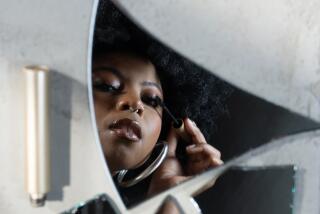Through the Good-Looking Glass : THE BEAUTY MYTH: How Images of Female Beauty Are Used Against Women, <i> By Naomi Wolf (William Morrow: $21.95; 325 pp.)</i>
I remember reading “The Feminine Mystique” my senior year on the steps of my dormitory at Mt. Holyoke College. I had a yellow highlighter pen and every other sentence I would madly underline because not only did Betty Friedan seem to have put her finger on a previously unnamed plight, but she was, by doing so, opening up doors and possibilities for me and my classmates. That was in 1970, the first year “Women’s History” was taught at Mt. Holyoke, and my yellow highlighter remained hyperactive underscoring Germaine Greer, Kate Millet and the classic Simone De Beauvoir.
Now, 20 years later, generations of women whose lives changed forever from those readings can look back with hindsight. The gains were innumerable, but there remains an undertow, a nagging erosion to those hard-earned victories.
Certainly the battle for reproductive rights is one that is still raging, and consumer images such as “The Good Housekeeping New Traditionalist” campaign--complete with squeaky-clean shirtwaist-clad mother with squeaky-clean Lacoste-clad sons in a squeaky-clean suburban house--are throwbacks to not-so-gentler, not-so-kinder times. In other words, though there have been amazing clear-cut victories, the white flag of total sexist surrender has yet to unfurl.
There are varying explantions for the undertow, the easiest being almost Hegelian; i.e. things take time; for every thesis there’s an antithesis before arriving at a new synthesis. Another would be that in order for the lives of women to change completely socially and politically, the life choices of men must politically and socially change. Now Naomi Wolf, in her book “The Beauty Myth,” offers a third explanation, the politicalization of beauty.
According to Wolf, “As soon as a woman’s primary social value could no longer be defined as the attainment of virtuous domesticity, the beauty myth redefined it as the attachment of virtuous beauty.” In other words, what is holding us back are no longer barriers to work, sex or political freedoms but an internal sense of inadequacy based on physical desirability.
A woman can be an accomplished doctor, lawyer, Indian Chief, but if she has cellulite on her thighs she is trained by the male Establishment and media to revile herself. “The myth” in Wolf’s mind, “is undermining--slowly, imperceptibly, without their being aware of the real forces of erosion--the ground women have gained through long hard struggle”
“The Beauty Myth” is a 1990s attempt at a sociological/feminist blockbuster, and Wolf does a thorough job. She plows through work, culture, religion, sex, hunger, even violence to attain her goal. With extensive historical, social and literary data, we are swept through the worlds of dangerous cosmetic surgery, life-threatening eating disorders, and even the appalling concept that by the year 2029, virtually all women will hate their breasts.
This revived worship of pulchritude has been created, according to Wolf, by the male political Establishment to not only maintain control in a world in which women were becoming too threatening but also to undermine future feminist gains. Wolf believes that the myth, along with the PBQ (Professional Beauty Quotient), is destroying not only women’s self-confidence but heterosexuality in general. In other words, a woman can’t enjoy sex as an equal partner if she is spending the entire time anxious about her sagging breasts, or squishy stomach.
Wolf means well. She is attempting to salvage women’s sense of self. Unfortunately, she points out, “The larger world never gives girls the message that their bodies are valuable simply because they are inside them,” and this undermining continues exponentially into middle age. “The Beauty Myth” has caused beautiful women to devalue their professional stature by attributing their success completely to their looks; conversely, so-called “ugly” women are unable to truly enjoy their accomplishments because they are obsessed with their beauty failures. Wolf’s desire is to smash the male-controlled gods of pulchritude and release the millions of downtrodden female worshipers.
So what’s wrong with giving a girl a lift? Nothing, except if the biggest issue for women today is dealing with a paralyzing beauty myth, then we have either come a great deal further than we thought or nowhere at all. Wolf advises:”We must now ask the questions about our place in our bodies that women asked a generation ago about their place in society.” If that’s all we really have to do, then I suppose reproductive rights, discrimination, child care, health care have all been settled.
Personally, I doubt that all women will hate their breasts in 2029. There may be two in Alaska and one in Cincinnati who actually likes them. And I don’t believe the diet program of 900 calories at major weight-loss centers can be compared to the regimen at Treblinka. These are sweeping generalizations used to bring a point home.
For some reason, it is always women who are the source from era to era of these generalizations. We’re either all going back into our kitchen, having it all, or now being undermined by a beauty myth. Yes, there has been a politicalization of beauty, but I’ve frankly noticed a few men who worship and tremble at the god of youthful pulchritude as well.
To be truly liberated, to revive and refresh the second wave of feminism, Naomi Wolf advises that “We must see that it does not matter what women look like so long as they feel beautiful.” I’m reminded of an Oil of Olay commercial promising me I can be beautiful at any age at 2 o’clock in the morning. Generally, I think about it for two minutes, make a note to myself to be sure to feel beautiful, and pass out. It’s an interesting point; it explains a few things, but it’s not earth-shaking.
To ignite a renewed wave of feminism, to reach the unsuspecting senior on her dormitory step and get her highlighting again, there is much more important work to be done and books to be written.
More to Read
Sign up for our Book Club newsletter
Get the latest news, events and more from the Los Angeles Times Book Club, and help us get L.A. reading and talking.
You may occasionally receive promotional content from the Los Angeles Times.







